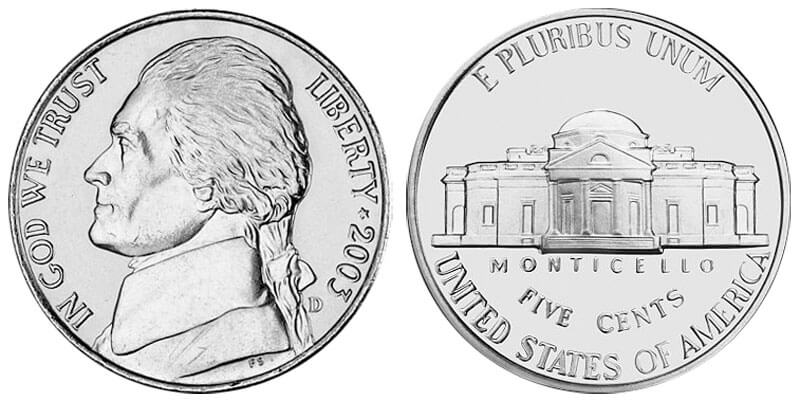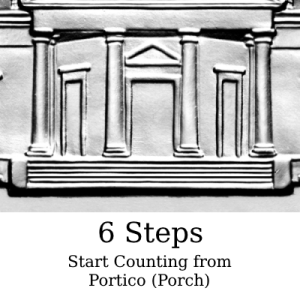Jefferson Nickel Value (1938–date)
The Jefferson nickel is the five-cent coin of the United States. It was introduced in 1938 to honor Founding Father and third US President Thomas Jefferson. The US Mint has produced more than 63 billion Jefferson nickels through 2019. This total includes the nearly 870 million silver "war nickels" between 1942 and 1945.
View a complete Jefferson nickel price chart at the bottom of this article

The Jefferson nickel continues to be produced today.
Collecting Jefferson Nickels
So many Jefferson nickels were made every year, it is easy to build a date and mint set of circulated coins. Even key date Jefferson nickels are cheap, compared to other coins.
Collectors focus on error coins and condition rarities like the Full Steps uncirculated dates instead.
Key Date Jefferson Nickels
High mintages for most Jefferson nickels mean that, for many dates, even uncirculated coins are cheap. In fact, semi-key dates like the 1938-D and 1938-S can be found in Mint State MS65 for less than $20.
Jefferson Nickel Errors
With 63 billion nickels minted since 1938, it’s no surprise that few dates are collectible on their own. Rather, error coins are the most common rare and valuable Jefferson nickels. You can check out our Jefferson nickel errors infographic for more information.
Most mint errors fall into two categories: Doubled Dies and Repunches.
Doubled Die Jefferson Nickels
With a run of more than 80 years, it’s surprising that there are only three major doubled die Jefferson nickels. The first of these is the famous 1939 “Doubled Monticello” Doubled Die Reverse. The other two occurred on WWII silver “war nickels”: the 1943-P “Doubled Eye” Doubled Die Obverse, and the 1945-P Doubled Die Reverse.
Repunched Jefferson Nickels
There are two types of punch errors on Jefferson nickels: repunched mint marks and overdates. Mint marks were punched onto coin dies by hand until the 1990s. It took multiple blows with a mallet to make the mintmark deep enough.
Sometimes, the punch would move slightly between strikes, causing a double image of the mint mark. These errors are known as Repunched Mint Marks (RPM). Repunched Mint Mark coins are indicated on coin dates by a repeated mint mark separated by a slash mark. For example, a repunched San Francisco Mint mark would be noted by "S/S" after the date. The most famous RPM Jefferson nickel is the 1942-D Over Horizontal D.
Full Steps Jefferson Nickels
Traditionally, there was little about Jefferson nickels to excite collectors. Aside from the few error coin dates, collecting a full set was trivial. That is, until "Full Steps collecting" became popular in the 1970s.
A “Full Steps” Jefferson nickel displays complete, undamaged steps on Monticello. Having Full Steps significantly increases the value of any Jefferson nickel, sometimes by as much as 10x to 20x its normal price. These condition rarities have become a focus for many coin collectors. Some Jefferson Nickel dates have very few surviving Full Steps coins. Two years, 1960-D and 1967, have no known Full Steps coins at all!
How Do I Tell If My Jefferson Nickel Has Full Steps?
There are six steps on Monticello on a Jefferson nickel, counting the portico (porch).
To tell if your Jefferson nickel has Full Steps, start counting from the portico. Check each step in turn. Any damage that cuts completely across a step disqualifies the coin.

The portico counts as Step #1. The foundation counts as Step #6.
Another way to check if your Jefferson nickel has Full Steps is to count the incuse lines between the steps. If the first four lines counting from the top are complete, the nickel has five full steps. If the bottom line is also undamaged and full, the nickel has six full steps.
5 complete lines = 6 Full Steps

Grading 5 Full Steps and 6 Full Steps Jefferson Nickels
There are two types of Full Step Jefferson nickels: Five Full Steps (5FS) and Six Full Steps (6FS). The two largest coin grading services, NGC and PCGS, have different definitions for Full Steps Jefferson nickels.

PCGS has always awarded the FS designation to Jefferson nickels that have either five or six full steps. Until 2004, NGC only awarded the FS designation to Jefferson nickels with six full steps. This was a much harder hurdle to clear, as there are far fewer six full steps nickels than five.

In 2004, NGC split their FS designation into 5FS and 6FS. PCGS has not followed suit. A Jefferson nickel graded FS by PCGS will need to be examined to determine whether it is a 5FS or 6FS.
Four-Figure Full Steps Jefferson Nickels
These Full Steps Jefferson nickels have sold for $1,000 or more in Mint State 65*. Note that there are no known Full Steps coins at any grade for some mintages. Some rare error nickels can also be found with Full Steps.This adds a premium to their already high prices.
*prices as of mid-2020
The Origin of the Jefferson Nickel
The Buffalo nickel by James Earle Fraser was introduced in 1913. The US Mint was unhappy with the design from the start. Nickel metal is much harder than silver or copper. This means nickel coins require a higher strike pressure than silver or copper coins.
Despite adjustments to the dies, the Mint still had problems getting full strikes on the Buffalo nickel. The decision was made to replace the design as soon as possible.
DID YOU KNOW?
Frequent die failures is one reason that the Mint abandoned a copper-nickel alloy for small cents in 1864.
The US Mint can replace any coin design that is at least 25 years old without the approval of Congress. The Buffalo nickel was introduced in 1913, which meant that in 1938, its time was up.
The US Mint wasted no time in finding a replacement. They announced a public competition for a new nickel design in January 1938. Designs had to feature an "authentic portrait" of Jefferson as the obverse. A representation of Jefferson's famous estate, Monticello was required on the reverse. The prize for the winning design was $1,000 ($18,000 in 2020 dollars). 390 entries were received by the April 15th deadline.
Sculptor Felix Schlag was declared the winner on April 24th. He apparently won on the strength of his profile of Jefferson, as Mint officials ordered everything else changed. The most contentious part of his original design was his close-up three-quarter view of Monticello. Critics charged that the image was unrecognizable. It was replaced by an ordinary head-on view. Schlag believed the image so generic that he added "Monticello" beneath the image.
1942–1945 Silver "War Nickels"

1942-P wartime Jefferson nickel
Nickel was needed for ship and tank armor, stainless steel engine parts, and military equipment in World War II. To conserve nickel, the US government changed the composition of the five-cent coin.
The original plan was for the silver "war nickels" to be 50% copper and 50% silver. Vending machines rejected the new coins during testing. The magnetic signature of the copper-silver alloy was too different from regular nickels. Adjusting the alloy to 56% copper, 35% silver, and 9% manganese solved the problem.
35% silver war nickels were minted from October 1942 through 1945. The government intended to remove them from circulation after the war. To facilitate this, the US Mint struck large mint marks over the dome of Monticello. This marked the first time the P mint mark, for the main US Mint in Philadelphia, was used on a coin.
As things turned out, the silver war nickels remained in circulation. The government decided it wasn't worth the effort to search billions of nickels for the silver ones. Silver war nickels circulated freely until the 1960s. High silver prices in the '60s saw millions of war nickels hoarded for their silver content. Even so, silver war nickels are still easy to find in coin shops.
Jefferson Nickel Price Chart
Prices listed as "FV" indicate that the coin is generally only worth its face value of 5 cents.
* Included in above mintage
